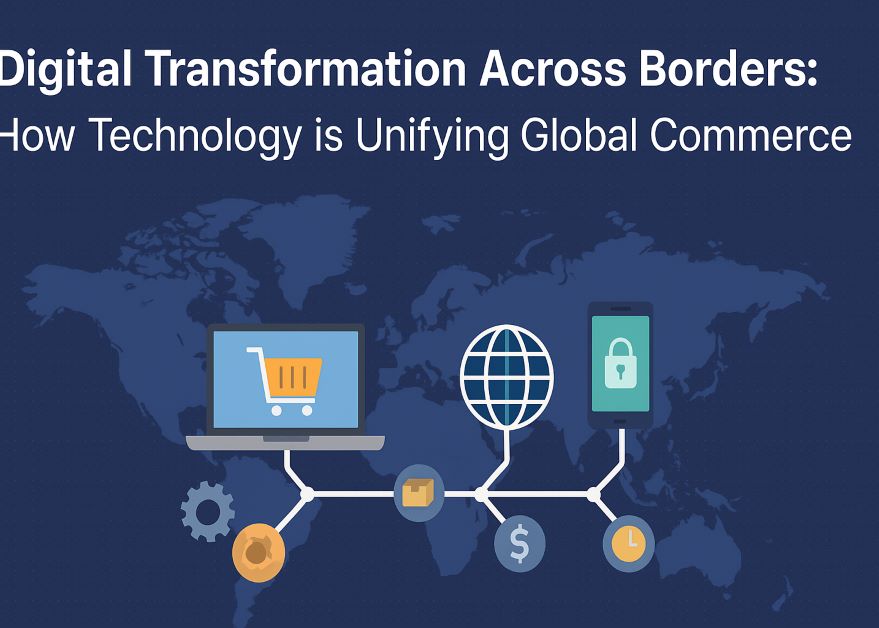In today’s globalized economy, technology is not merely an enabler of commerce—it is the foundation of a new era of borderless business. From artificial intelligence to blockchain, cloud computing to cross-border e-commerce, digital transformation is rapidly dissolving traditional barriers and creating an interconnected commercial landscape.
As we enter the midpoint of the 2020s, businesses worldwide are leveraging technology to expand globally, collaborate in real time, and serve international markets faster and more efficiently. This wave of digital transformation is fundamentally reshaping how global commerce functions, enhancing accessibility, transparency, and resilience across supply chains and consumer channels alike.
1. The Rise of Borderless Digital Commerce
The most visible impact of digital transformation is the growth of cross-border e-commerce. Consumers from different continents can now order products from anywhere in the world with a few taps on a smartphone. Platforms like Amazon, Alibaba, Mercado Libre, and Shopify have enabled small and medium-sized enterprises (SMEs) to become global sellers overnight.
Digital payments systems such as Stripe, PayPal, and Wise make it easy for companies to accept multi-currency payments. Meanwhile, international logistics and fulfillment services have evolved to offer real-time tracking, customs clearance automation, and last-mile delivery, even in remote regions.
This flattening of global retail is breaking down entry barriers for businesses, especially in emerging markets, allowing them to access buyers across the globe without needing physical infrastructure abroad.
2. Cloud Computing and Scalable Global Operations
Cloud-based platforms are at the heart of digital globalization. With tools like Amazon Web Services (AWS), Google Cloud, and Microsoft Azure, companies can deploy applications, manage databases, and store customer data across continents—without building local servers.
Cloud infrastructure allows businesses to:
Collaborate in real-time across time zones
Launch products globally from a single interface
Securely store and manage international data
Scale up or down depending on demand
This digital agility enables even small firms to operate like multinationals, reaching international markets with unprecedented speed and efficiency.
3. Artificial Intelligence (AI) and Predictive Analytics
AI is playing a pivotal role in global commerce by improving decision-making, automating processes, and enhancing the customer experience. Natural Language Processing (NLP) allows businesses to serve multilingual audiences through real-time translation and localized customer support.
AI-powered analytics can:
Predict market trends
Personalize recommendations for diverse demographics
Optimize global supply chain logistics
Identify and mitigate compliance risks
Multinational retailers use AI to monitor global purchasing behavior, forecast demand by region, and adjust inventory distribution accordingly. The result is faster, smarter, and more customer-centric international trade.
4. Blockchain for Transparency and Trust
Cross-border transactions often suffer from fraud, regulatory complexity, and lack of transparency. Blockchain technology offers a solution through its decentralized and tamper-proof ledger system.
Applications in global trade include:
Smart contracts for automatic execution of payment and delivery terms
Supply chain tracking to verify product origin and compliance
Digital identities for secure international KYC (Know Your Customer) verification
Tokenization of assets, enabling fractional ownership and digital trade of commodities or real estate
By fostering trust among international partners and minimizing disputes, blockchain is helping to simplify and secure global transactions.
5. Unified Global Workforce Through Digital Tools
Technology is also transforming how companies hire, manage, and collaborate with international talent. Remote work tools like Zoom, Slack, Trello, and Notion enable seamless cross-border teamwork. Cloud-based HR platforms like Deel, Remote, and Oyster help businesses handle:
Global payroll
Compliance with labor laws
Taxation across jurisdictions
This decentralization of the workforce is driving a new era of digital nomadism and global hiring, allowing companies to access talent from anywhere and individuals to work for employers across the world.
In sectors such as tech, design, consulting, and marketing, geography is no longer a limiting factor.
6. Digital Infrastructure and Government Policy
Governments are recognizing the importance of digital transformation in trade and are investing heavily in digital infrastructure and policy reforms. Countries in Africa and Southeast Asia are rapidly digitizing customs procedures, port logistics, and public services.
Moreover, digital trade agreements are emerging, such as the Digital Economy Partnership Agreement (DEPA) among Singapore, Chile, and New Zealand. These agreements address cross-border data flow, cybersecurity, and e-commerce regulation—creating a more cohesive and secure digital trade environment.
International business is now influenced not just by tariffs and taxes, but also by data sovereignty, cloud hosting laws, and AI governance—a shift that businesses must adapt to strategically.
7. Digital Inclusion and Emerging Market Opportunities
One of the most transformative effects of digital globalization is the inclusion of underserved populations in the global economy. Affordable smartphones, mobile money platforms, and local e-commerce apps are connecting millions in Africa, South Asia, and Latin America to international markets.
Businesses that invest in local language interfaces, mobile-first platforms, and accessible payment systems are gaining first-mover advantages in these high-growth regions.
Inclusion also extends to SMEs, many of whom are now selling globally through online marketplaces and social media platforms without needing export licenses or brick-and-mortar stores.
8. Cybersecurity and Cross-Border Risk Management
With increased digitization comes greater exposure to cyber threats. International businesses must now navigate cybersecurity risks, data privacy regulations (like GDPR or China’s PIPL), and cross-border compliance standards.
Modern firms are deploying AI-driven security systems, data encryption, and zero-trust architectures to protect digital infrastructure while staying compliant with global legal frameworks.
Digital transformation is not just about enabling trade—it’s about securing it for the long run.
Conclusion: A Digitally Unified Future
The digital revolution is redefining how global commerce operates—making it faster, fairer, and more flexible. As technology continues to dissolve traditional borders, companies that embrace digital transformation are poised to lead in a rapidly evolving global economy.
Success in this new environment requires more than adopting new tools; it demands a strategic mindset that understands how to integrate digital processes, comply with evolving regulations, and build lasting cross-border relationships.
Global commerce is no longer limited by physical distance. In a digitally unified world, the future belongs to businesses that can act local, scale global, and think digital.



